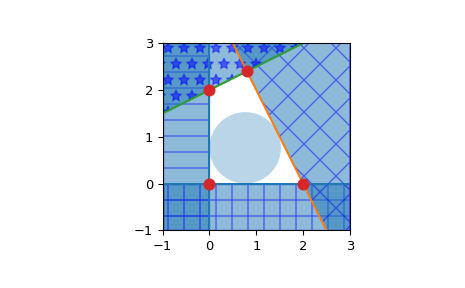本文簡要介紹 python 語言中 scipy.spatial.HalfspaceIntersection 的用法。
用法:
class scipy.spatial.HalfspaceIntersection(halfspaces, interior_point, incremental=False, qhull_options=None)#N 維的半空間交點。
- halfspaces: 浮點數的ndarray,形狀(nineq,ndim+1)
Ax + b <= 0 形式的堆疊不等式,格式為 [A;乙]
- interior_point: 浮點數的ndarray,形狀(ndim,)
清楚地指向由半空間定義的區域內。也稱為可行點,可以通過線性規劃得到。
- incremental: 布爾型,可選
允許增量添加新的半空間。這會占用一些額外的資源。
- qhull_options: str,可選
傳遞給 Qhull 的其他選項。有關詳細信息,請參閱 Qhull 手冊。 (默認值:“Qx” 用於 ndim > 4,否則為“”)選項 “H” 始終啟用。
- QhullError
當 Qhull 遇到錯誤條件時引發,例如在未啟用解決選項時出現幾何退化。
- ValueError
如果將不兼容的數組作為輸入給出,則引發。
參數 ::
拋出 ::
注意:
使用 Qhull library 計算交點。這再現了 Qhull 的“qhalf” 函數。
參考:
[1]S. Boyd、L. Vandenberghe,凸優化,可在 http://stanford.edu/~boyd/cvxbook/ 獲得
例子:
形成一些多邊形的平麵的半空間相交
>>> from scipy.spatial import HalfspaceIntersection >>> import numpy as np >>> halfspaces = np.array([[-1, 0., 0.], ... [0., -1., 0.], ... [2., 1., -4.], ... [-0.5, 1., -2.]]) >>> feasible_point = np.array([0.5, 0.5]) >>> hs = HalfspaceIntersection(halfspaces, feasible_point)將半空間繪製為填充區域和交點:
>>> import matplotlib.pyplot as plt >>> fig = plt.figure() >>> ax = fig.add_subplot(1, 1, 1, aspect='equal') >>> xlim, ylim = (-1, 3), (-1, 3) >>> ax.set_xlim(xlim) >>> ax.set_ylim(ylim) >>> x = np.linspace(-1, 3, 100) >>> symbols = ['-', '+', 'x', '*'] >>> signs = [0, 0, -1, -1] >>> fmt = {"color": None, "edgecolor": "b", "alpha": 0.5} >>> for h, sym, sign in zip(halfspaces, symbols, signs): ... hlist = h.tolist() ... fmt["hatch"] = sym ... if h[1]== 0: ... ax.axvline(-h[2]/h[0], label='{}x+{}y+{}=0'.format(*hlist)) ... xi = np.linspace(xlim[sign], -h[2]/h[0], 100) ... ax.fill_between(xi, ylim[0], ylim[1], **fmt) ... else: ... ax.plot(x, (-h[2]-h[0]*x)/h[1], label='{}x+{}y+{}=0'.format(*hlist)) ... ax.fill_between(x, (-h[2]-h[0]*x)/h[1], ylim[sign], **fmt) >>> x, y = zip(*hs.intersections) >>> ax.plot(x, y, 'o', markersize=8)默認情況下,qhull 不提供計算內點的方法。這可以很容易地使用線性規劃來計算。考慮 形式的半空間,求解線性程序:
是 A 的行,即每個平麵的法線。
將產生一個在凸多麵體內部最遠的點 x。準確地說,它是多麵體中半徑為 y 的最大超球麵的中心。該點稱為多麵體的切比雪夫中心(參見 [1] 4.3.1,pp148-149)。 Qhull 輸出的方程總是被歸一化的。
>>> from scipy.optimize import linprog >>> from matplotlib.patches import Circle >>> norm_vector = np.reshape(np.linalg.norm(halfspaces[:, :-1], axis=1), ... (halfspaces.shape[0], 1)) >>> c = np.zeros((halfspaces.shape[1],)) >>> c[-1] = -1 >>> A = np.hstack((halfspaces[:, :-1], norm_vector)) >>> b = - halfspaces[:, -1:] >>> res = linprog(c, A_ub=A, b_ub=b, bounds=(None, None)) >>> x = res.x[:-1] >>> y = res.x[-1] >>> circle = Circle(x, radius=y, alpha=0.3) >>> ax.add_patch(circle) >>> plt.legend(bbox_to_anchor=(1.6, 1.0)) >>> plt.show()
- halfspaces: ndarray of double, shape (nineq, ndim+1)
輸入半空格。
- interior_point :ndarray of floats, shape (ndim,):
輸入內點。
- intersections: ndarray of double, shape (ninter, ndim)
所有半空間的交點。
- dual_points: ndarray of double, shape (nineq, ndim)
輸入半空間的對偶點。
- dual_facets: 整數列表列表
形成雙凸包的(不一定是單純的)麵的點的索引。
- dual_vertices: 整數的ndarray,形狀(nvertices,)
形成雙凸包頂點的半空間索引。對於二維凸包,頂點按逆時針順序排列。對於其他維度,它們按輸入順序排列。
- dual_equations: ndarray of double, shape (nfacet, ndim+1)
[normal, offset] 形成雙麵的超平麵方程(更多信息請參見Qhull documentation)。
- dual_area: 浮點數
雙凸包麵積
- dual_volume: 浮點數
雙凸包的體積
屬性 ::
相關用法
- Python SciPy spatial.tsearch用法及代碼示例
- Python SciPy spatial.Voronoi用法及代碼示例
- Python SciPy spatial.procrustes用法及代碼示例
- Python SciPy spatial.SphericalVoronoi用法及代碼示例
- Python SciPy spatial.minkowski_distance用法及代碼示例
- Python SciPy spatial.voronoi_plot_2d用法及代碼示例
- Python SciPy spatial.minkowski_distance_p用法及代碼示例
- Python SciPy spatial.geometric_slerp用法及代碼示例
- Python SciPy spatial.distance_matrix用法及代碼示例
- Python SciPy spatial.ConvexHull用法及代碼示例
- Python SciPy spatial.convex_hull_plot_2d用法及代碼示例
- Python SciPy spatial.Delaunay用法及代碼示例
- Python SciPy spatial.delaunay_plot_2d用法及代碼示例
- Python SciPy sparse.isspmatrix用法及代碼示例
- Python SciPy sparse.save_npz用法及代碼示例
- Python SciPy sparse.issparse用法及代碼示例
- Python SciPy sparse.coo_matrix用法及代碼示例
- Python SciPy sparse.isspmatrix_csc用法及代碼示例
- Python SciPy sparse.isspmatrix_csr用法及代碼示例
- Python SciPy sparse.tril用法及代碼示例
- Python SciPy sparse.coo_array用法及代碼示例
- Python SciPy sparse.dia_array用法及代碼示例
- Python SciPy sparse.bmat用法及代碼示例
- Python SciPy sparse.hstack用法及代碼示例
- Python SciPy sparse.rand用法及代碼示例
注:本文由純淨天空篩選整理自scipy.org大神的英文原創作品 scipy.spatial.HalfspaceIntersection。非經特殊聲明,原始代碼版權歸原作者所有,本譯文未經允許或授權,請勿轉載或複製。
